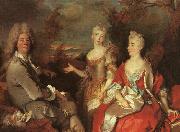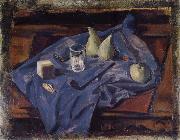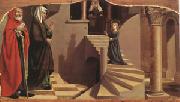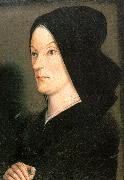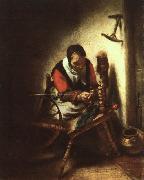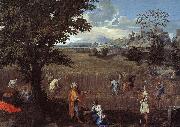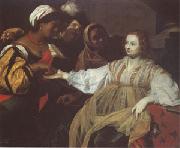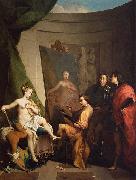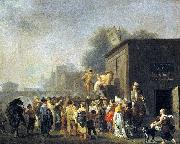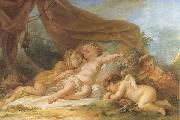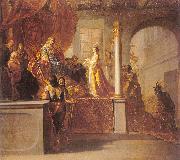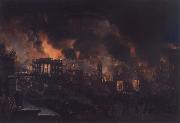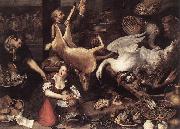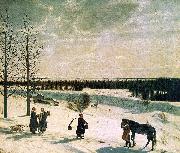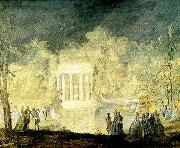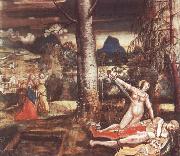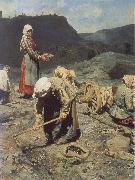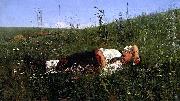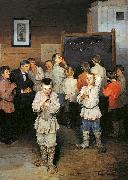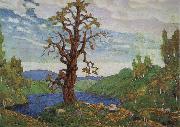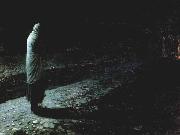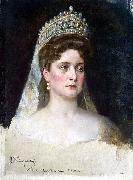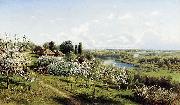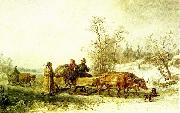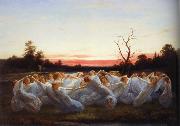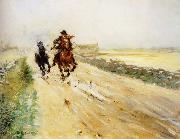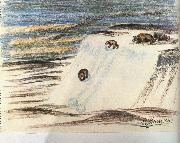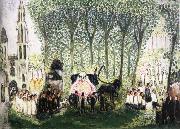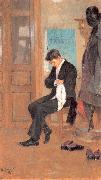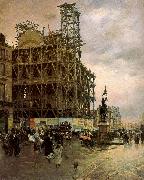|
|
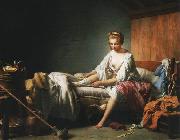 |
Nicolas Bernard Lepicie
|
|
was a French painter (16 June 1735 - 15 September 1784), the son of two reputed engravers at the time, Francois-Bernard and Renee-Elisabeth, was introduced to the artistic and cultural environment by his parents.
Nicolas-Bernard studied with reputed artists of the century including Carle Vanloo. In 1769 he was accepted to the Royal Academy of Painting and Sculpture in Paris. Three years later, in 1770, he became an assistant professor and, in 1777, a professor. Important names such as Carle Vernet, Jean-Frederic Schall, Jean-Antoine-Theodore Giroust, Jean-Joseph Taillasson, Henri-Pierre Danloux, Jean-Baptiste Regnault and Nicolas-Antoine. |
|
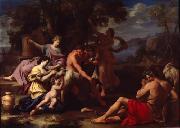 |
Nicolas Chaperon
|
|
Nicolas Chaperon (Châteaudun, bapt. 19 October 1612 e Lyon 1656) was a French painter, draughtsman and engraver, a student in Paris of Simon Vouet whose style he adopted before he was further matured by his stay in Rome (1642-51) in the studio of Nicolas Poussin.
In 1653-55 the consuls de Lyon called him to decorate the hôtel de ville but Chaperon dying almost as soon as he arrived, the commission passed to Thomas Blanchet. Chaperon made a name for himself with his suite of engravings after the Raphael Loggie of the Vatican, Rome, 1649, but art historians remember him for the stream of fulminating invective with which Poussin in his correspondence with Paul Freart de Chantelou described this unruly and vindictive practician who refused to carry through his copy of a Transfiguration. So little is known of Chaperon that this episode stands out. |
|
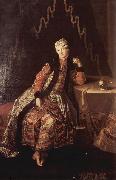 |
Nicolas de Largilliee
|
|
Largilliere's father, a merchant, took him to Antwerp at the age of three. As a boy, he spent nearly two years in London. Sometime after his return to Antwerp, a failed attempt at business led him to the studio of Goubeau. However, Largilliere left at the age of eighteen and went to England, where he was befriended and employed by Peter Lely for four years at Windsor, Berkshire.
Painting careerEarly careerHis painting caught the attention of Charles II, who wished to retain Largilliere in his service, but the controversy aroused by the Rye House Plot against Roman Catholics alarmed Largilliere. Largilliere left for Paris, where he was well-received by the public as a painter.
Upon ascending to the throne in 1685, James II requested Largilliere to return to England. James II offered Largilliere the office of keeper of the royal collections, but he declined due to being uneasy about Rye House Plot. However, during a short stay in London, he painted portraits of the king, the queen Mary of Modena, and the prince of Wales James Francis Edward Stuart. The portrait of the Prince of Wales could not have been painted during Largilliere's stay in London because the prince was not born until 1688. The three portraits painted by Largilliere of the prince in his youth must have been executed in Paris, where he returned sometime before March 1686. The portrait of King James II was painted in 1686. King James is portrayed in golden armor with a white cravat and is positioned in front of a watercolour-like background set in a round frame. |
|
|
|
|
|
|
|
|
|
|
|
|
|
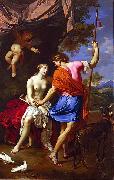 |
Nicolas Mignard
|
|
(1606-1668) was a French 17th Century painter. He spent most of his active life in Avignon and was the older brother of Pierre Mignard.
Nicolas Mignard was born in Troyes in 1606. There, he studied painting with a local master. After traveling to Fontainebleau, Mignard came to Avignon in 1632. He then traveled to Rome with Cardinal Archbishop of Lyon. Mignard came back to Avignon in 1636, after having executed multiple series of etching in Rome. There, he mostly painted for religious institutions. Mignard spent the end of his life in Paris, where he became a successful portrait painter. Mignard left Paris after a visit of King Louis XIV and his Court in Avignon. King Louis XIV decided to bring Mignard to Paris. Mignard eventually joined the Academie Royale.
Mignardes spending most of his life in Avignon made his career somewhat overshadowed by his little brother Pierre, who was installed in Paris. After his death, paintings by Nicolas Mignard mostly stayed in Avignon or in small cities around Avignon. During the French Revolution, as these paintings were taken over, most of them were attributed to Pierre Mignard.
His art is now rediscovered. His style is typical of the Italianate classicizing aesthetic that dominated seventeenth-century France, and obviously was very much influenced by French classical Baroque painter Poussin.
Nicolas Mignard died in 1668 in Paris.
|
|
|
|
Nicolas Neufchatel
|
|
Nicolas Neufchâtel (fl. 1539-1567)
Alternative names Nicolas de Neufchâtel, Nicolaes Neufchatel, Lucidel
Description Southern Netherlandish painter and draughtsman
|
|
|
|
|
|
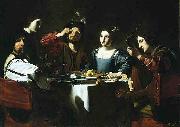 |
Nicolas Tournier
|
|
(baptised 12 July 1590 - d. before February 1639) was a French Baroque painter.
Born in Montbeliard, he followed the profession of his father, Andre Tournier, "a Protestant painter from Besançon". Little is known of his life before his arrival in Rome, where he worked between 1619 and 1626, and where he was influenced by the work of Caravaggio. According to one early source, he was a pupil of Valentin de Boulogne.Tournier's Roman paintings are stylistically close to the works of Bartolomeo Manfredi. He painted both secular and religious subjects; an example of the latter is The Crucifixion with St. Vincent de Paul (Paris, The Louvre). After 1626 Tournier was active in southern France. He died in Toulouse.
His work The Carrying of the Cross, painted around 1632, originally hung in the Toulouse chapel of the Company of the Black Penitents. During the French Revolution it was confiscated by the state and moved to a museum, from where it was stolen in 1818. After being lost for nearly two centuries, it reappeared in 2009 during an art collector's estate sale in Florence; when the Weiss Gallery of London purchased it in a Paris auction in 2011, the French government classified it as stolen property and banned it from leaving the country. |
|
|
|
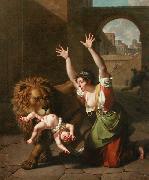 |
Nicolas-Andre Monsiau
|
|
(1754 -- 31 May 1837) was a French history painter and a refined draughtsman who turned to book illustration to supplement his income when the French Revolution disrupted patronage. His cool Poussiniste drawing style and coloring marked his conservative art in the age of Neoclassicism.
His training at the school of the Academie royale de peinture et de sculpture, Paris, was under the direction of Jean-François-Pierre Peyron. An early patron, the marquis de Corberon, paid for a sojourn at Rome, where he studied at the French Academy in Rome from 1776. On his return to Paris, he was unable to exhibit in the annual Paris salons, which were closed to all but those who had been received by the Academie or were members, under the Ancien Regime. Instead he found an outlet in the smaller Salon de la correspondance, where in 1782 he showed a tenebrist Piquant effect of the light of a lamp.
Two years later he was received at the Academie with a historical subject, Alexander taming Bucephalus and was made a member 3 October 1787, his second attempt, on the strength of The Death of Agis. The influence of Jacques-Louis David, an acquaintance from Monsiau's days in Rome, is most vividly represented by Monsiau's Ulysses, after returning to his palace and slaying Penelope's suitors, orders the women to remove the corpses (1791 Salon), where the action is played out in a shallow frieze-like space defined by a colonnade parallel to the picture plane.
In his best-known painting, Zeuxis choosing among the most beautiful girls of Crotona, shown at the Salon of 1791,Monsiau illustrates an anecdote of the painter Zeuxis, recorded in Pliny's Natural History, that exemplifies an essential aspect of the Classical approach to artistic creation, in the artist's refining an ideal Art by selecting from among the lesser beauties of Nature.
Monsiau's great public commission was a commemoration of the occasion on 26 January 1802, at which Napoleon delivered an authoritarian constitution to the Cisalpine Republic at a convocation of notables (the consulta) at Lyon. François Gerard had turned down the commission, preferring to continue his series of individual portraits of the Bonapartes. Monsiau received the commission in 1806; the finished painting was exhibited at the Salon of 1808 and was installed at the Tuileries the following year.
Monsiau was among the first history painters to depict scenes from modern history that were not commemorations of battles. He showed Moliere reading Tartuffe at the house of Ninon de Lenclos at the Salon of 1802. It was engraved by Jean-Lous Anselin. His painting of Louis XVI giving instructions to the sea captain-explorer La Perouse before his attempted circumnavigation was exhibited at the Salon of 1817 and was purchased for the recently restored Louis XVIII.
His portrayal of a sensational episode in which an escaped lion from the Grand Ducal menagerie in Florence had dropped a child it had picked up, without harming it, was exhibited at the Salon of 1801 and is conserved in the Louvre.
Among his pupils was the portrait draughtsman Louis Letronne (1790--1842), whose pencil portrait of Ludwig van Beethoven is iconic. |
|
|
|
|
|
|
|
|
|
|
|
|
|
|
|
|
|
 |
Niko Pirosmanashvili
|
|
(born Niko Pirosmanashvili; May 5, 1862-1918) was a Georgian primitivist painter.
Pirosmani was born in the Georgian village of Mirzaani to a pleasant family in the Kakheti province. His family owned a small vineyard. He was later orphaned and put in the care of his two elder sisters. He moved with them to Tbilisi in 1870. In 1872 he worked as a servant for wealthy families and learned to read and write Russian and Georgian. In 1876 he returned to Mirzaani and worked as a herdsman.
Pirosmani gradually taught himself to paint. One of his specialties was painting directly into black oilcloth. In 1882 he opened a workshop in Tbilisi which was unsuccessful. In 1890 he worked as a railroad conductor, and in 1895 worked creating signboards. In 1893 he co-founded a dairy farm in Tbilisi which he left in 1901. Throughout his life Pirosmani, who was always poor, was willing to take up ordinary jobs including housepainting and whitewashing buildings. Although his paintings had some local popularity (about 200 survive) his relationship with professional artists remained uneasy; making a living was always more important to him than abstract aesthetics. |
|
 |
Niko Pirosmani
|
|
Pirosmani was born in the Georgian village of Mirzaani to a peasant family in the Kakheti province. His family owned a small vineyard. He was later orphaned and put in the care of his two elder sisters. He move with them to Tbilisi in 1870. In 1872 he worked as a servant for wealthy families and learned to read and write Russian and Georgian. In 1876 he returned to Mirzaani and worked as a herdsman.
Pirosmani gradually taught himself to paint. One of his specialties was painting directly into black oilcloth. In 1882 he opened a workshop in Tbilisi which was unsuccessful. In 1890 he worked as a railroad conductor, and in 1895 worked creating signboards. In 1893 he co-founded a dairy farm in Tbilisi which he left in 1901. Throughout his life Pirosmani, who was always poor, was willing to take up ordinary jobs including housepainting and whitewashing buildings. Although his paintings had some local popularity (about 200 survive) his relationship with professional artists remained uneasy; making a living was always more important to him than abstract aesthetics. |
|
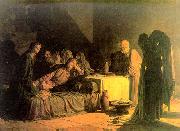 |
Nikolai Ge
|
|
1831 C 13 June [O.S. 1 June] 1894) was a Russian realist painter famous for his works on historical and religious motifs.
Nikolai Ge was born in Voronezh to a Russian noble family of French origin. His grandfather emigrated to Russia in the 18th century. His parents died when he was still a child, so Nikolai was raised by his serf nurse. He graduated from the First Kiev Gymnasium and studied at the physics-mathematics department of Kiev University and Saint Petersburg University.
In 1850 he gave up his career in science and entered the Imperial Academy of Arts in Saint Petersburg. He studied in academy under the historical painter Pyotr Basin until 1857. He graduated from the academy in 1857 with a gold medal for his painting The Witch of Endor Calling Up the Spirit of the Prophet Samuel. According to Ge himself, during that period he was strongly influenced by Karl Brullov.
His gold medal provided him a scholarship for studying abroad . He visited Germany, Switzerland, France and in 1860 settled in Italy. In Rome he met Alexander Andreyevich Ivanov who strongly influenced Ge. In 1861 Ge painted The Last Supper; in 1863 he took the painting with him to Saint Petersburg. Ge found his own interpretation of the classical subject ?? he emphasized the motif of discord among those who had formerly shared the same views. The painting (bought by Tsar Alexander II of Russia) made so strong impression that Ge was made a professor of Imperial Academy of Arts.
In 1864 he returned to Florence where he became a friend of a major Russian pro-Western writer and thinker Alexander Herzen and painted his portrait. The same year he also painted Messengers of the Resurrection and the first version of the Christ on the Mount of Olives. |
|
|
|
|
|
|
|
|
|
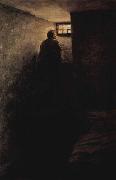 |
Nikolai Yaroshenko
|
|
(Ukrainian: Mykola Oleksandrovych Yaroshenko; Russian: December 13 [O.S. Dec. 1] 1846 in Poltava - July 7 [O.S. June 25] 1898 in Kislovodsk) was a Russian painter of Ukrainian origin.
Nikolai Alexandrovich Yaroshenko was born on December 13 [O.S. Dec. 1] 1846 in the city of Poltava, Russian Empire (now in Ukraine) to a son of a Russian Army officer. He chose a military career, but also studied art at Kramskoi's drawing school and at the Saint Petersburg Imperial Academy of Arts.
In 1876, he became a leading member of a group of Russian painters called the Peredvizhniki (also known as the Itinerants). |
|
|
|
|
|
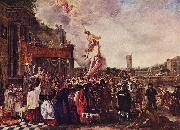 |
Nikolaus Knupfer
|
|
(1609 - 1655) was a Dutch Golden Age painter.
Knepfer was trained in Leipzig, where according to Houbraken he was apprenticed to Emanuel Nysen. He then moved to Magdeburg where he found work making brushes for artists. He stayed there until 1630, and then moved to Utrecht to work with Abraham Bloemaert. He lived with him for two years and then established his own studio in Utrecht, where in 1637 he became a visiting member of the Guild of St. Luke. He worked on the decorations of the castle Kronborg in Denemarken, and painted figures in the landscapes of Jan Both and Jan Baptist Weenix. Knepfer was a successful teacher, whose students were great painters after him, such as Jan Steen, Gabriel Metsu, Ary de Vois, and Pieter Crijnse Volmarijn. |
|
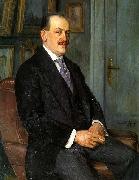 |
Nikolay Bogdanov-Belsky
|
|
(Russian 1868-1945) was a Russian painter.
Bogdanov-Belsky was born in the village of Shitiki in Smolensk Governorate in 1868. He studied art at the Semyon Rachinsky fine art school, icon-painting at the Troitse-Sergiyeva Lavra in 1883, modern painting at the Moscow School of Painting, Sculpture and Architecture in 1884 to 1889, and at the Imperial Academy of Arts in St. Petersburg from 1894 to 1895. He worked and studied in private studios in Paris in the late 1890s.
Bogdanov-Belsky was active in St. Petersburg. After 1921, he worked exclusively in Riga, Latvia. He became a member of several prominent societies in including the Peredvizhniki from 1895, and the Arkhip Kuindzhi Society from 1909 (of which he was a founding member and chairman from 1913 to 1918).
Bogdanov-Belsky painted mostly genre paintings, especially of the education of peasant children, portraits, and impressionistic landscapes studies. He became pedagogue and academician in 1903. He was an active Member of the Academy of Arts in 1914. Bogdanov-Belsky died in 1945 in Berlin.
He was a member of the Russian Fraternitas Arctica in Riga.
|
|
|
|
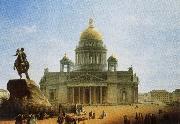 |
nikolay gogol
|
|
With the works of the Russian author Nikolai Gogol (1809-1852) the period of Russian imitation of Western literature ended. He found inspiration in native materials and combined realistic detail with grotesque and otherworldly elements. |
|
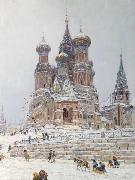 |
Nikolay Nikanorovich Dubovskoy
|
|
Russian, December 17, 1859 - February 28, 1918) was a Russian landscape painter.
He studied from 1877 to 1881 at the Imperial Academy of Arts in Saint Petersburg under Mikhail Konstantinovich Klodt. In 1886, he became a member of the Peredvizhniki (the Wanderers), a group of Russian painters. In 1900, he became a member of the Academy of Arts. |
|
|
|
|
|
|
|
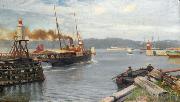 |
Nils Hansteen
|
|
(1855-1912) was a Norwegian painter.
Nils Hansteen was born in Mo i Rana, in the county of Nordland, Norway. He attended the painting school of Knud Bergslien from 1873 and Peder Thurmann Cappelen (1874-1975). He later studied under Hans Gude in Karlsruhe from 1876 to 1877. He then lived in Munich (1877-1880), Italy (1880-1881) and Copenhagen (1887-1892).
He was known principally as a landscape and marine painter. He painted in a naturalistic style, with motifs from marine and forest environments. Two of his paintings are owned by the National Gallery of Norway. |
|
|
|
|
|
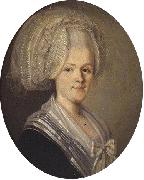 |
Nils Schillmark
|
|
Nils Schillmark (1745-1804)Aliases: Nils Schillmarch; Nils Schillmarck; Nils SkiellmarkProfessions: Portrait painter; Landscape painter; Painter.
(b Skellefteå, northern Sweden, 1745; d 1804). Finnish painter of Swedish birth. The son of a crofter, he was apprenticed in Stockholm to Pehr Fjellström, an artist and military officer. It is possible that Schillmark also studied at the Swedish Royal Academy of Art. He accompanied Fjellström on journeys to Finland and eventually moved there in 1773, first staying in Viaborg, the fortress situated off the shore near Helsinki, and later moving to the mainland and settling in Helsinki. In 1777 he began to receive commissions for portraits, and from then on he spent most of his life as a travelling portrait painter. His sitters came from both the bourgeoisie and the landed gentry, but they were widely spread across southern and western Finland. Occasionally Schillmark also received other kinds of commissions, for example for an altarpiece for the old stone church in Hattula (in situ). From 1787 Schillmark lived permanently in the town of Loviisa, but he continued to tour the estates of the neighbouring countryside. His only landscape paintings to have been preserved are from this year and show the town of Heinola and its new residence for the governor of the Uusimaa and Häme districts. A few years later Schillmark produced a number of still-life paintings for this building. It is possible that he spent some time in Stockholm during this period. |
|
|
|
|
|
|
|
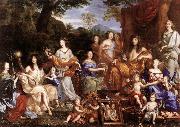 |
NOCRET, Jean
|
|
French painter (b. 1617, Nancy, d. 1672, Paris). |
|
|










